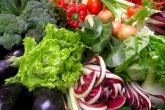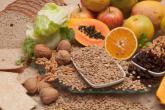Introduction
Functions of carbohydrates
Nutritional requirements
Classification of carbohydrates, sources, interesting facts
Introduction
Carbohydrates
(also saccharides or commonly sugars) are organic compounds - multihydroxide alcohols consisting of
carbon, hydrogen and oxygen, in which hydrogen to oxygen ratio is the same as in water
(H2O) so it equals 2:1. Carbohydrates are in all commonly existing
plants: cereals, potatoes, pod plants, fruit and also in animal organisms.
|
|
|
Functions of carbohydrates
-
carbohydrates (sugars) are the cheapest and easiest accessible source of energy which is used first of all to keep constant body temperature, work of internal organs and to execute physical labor, 1 g of carbohydrates releases 4 kcal of energy,
-
glucose is almost the only energy source for brain and muscles,
-
carbohydrates allow to economical balance of proteins and fats,
-
carbohydrates provided in nourishment or synthesized in organism constitute building material for formation of structural elements of cells or biologically active substances (galactose, ribose, galacturonic acid, ammonosugars, acetylated sugars etc),
-
unprocessed (integrated) carbohydrates play a big role in water-mineral balance decreasing secretion of these ingredients,
-
carbohydrates participate in build of cell membranes,
-
some polysaccharides (dietary fiber), although they are not digested and absorbed by human's organism, play a big role in regulation of digestive system peristalsis.
Nutritional requirements
Carbohydrates
(Sugars) should provide 45-65% of energetic value of an adult's daily nourishing
ration. They ought to be complex, unpurified and not-boiled to a pulp
carbohydrates.
RDA for various life stage groups
| Life stage group | Carbohydratess | |
|---|---|---|
|
Recommended Dietary Allowances (RDA) [g/day] |
Acceptable Macronutrient Distribution Range (AMDR)*1 [%] |
|
| Infants 0-6 months | 60 | ND |
| Infants 6-12 months | 95 | ND |
| Children 1-3 years | 130 | 45-65 |
| Children 4-8 years | 130 | 45-65 |
| Males 9-13 years | 130 | 45-65 |
| Males 14-18 years | 130 | 45-65 |
| Males 19-30 years | 130 | 45-65 |
| Males 31-50 years | 130 | 45-65 |
| Males 51-70 years | 130 | 45-65 |
| Males > 70 years | 130 | 45-65 |
| Females 9-13 years | 130 | 45-65 |
| Females 14-18 years | 130 | 45-65 |
| Females 19-30 years | 130 | 45-65 |
| Females 31-50 years | 130 | 45-65 |
| Females 51-70 years | 130 | 45-65 |
| Females > 70 years | 130 | 45-65 |
| Pregnancy ? 18 years | 175 | 45-65 |
| Pregnancy 19-30 years | 175 | 45-65 |
| Pregnancy 31-50 years | 175 | 45-65 |
| Lactation ? 18 years | 210 | 45-65 |
| Lactation 19-30 years | 210 | 45-65 |
| Lactation 31-50 years | 210 | 45-65 |
*1 Acceptable Macronutrient Distribution Range (AMDR) is the
range of intake for a particular energy source that is associated with
reduced risk of chronic disease while providing intakes of essential
nutrients. If an individuals consumed in excess of the AMDR, there is a potential of increasing the risk of chronic diseases and insufficient
intakes of essential nutrients.
ND = Not determinable due to
lack of data of adverse effects in this age group and concern with
regard to lack of ability to handle excess amounts. Source of intake
should be from food only to prevent high levels of intake.
Classification of carbohydrates, sources, interesting facts
We divide carbohydrates
(sugars) into simple,
compound low-molecular, compound multimolecular and derived carbohydrates.
Simple carbohydrates - Monosaccharides
Compound
low-molecular carbohydrates -
Oligosaccharides
Compound multimolecular carbohydrates - Polysaccharides
-
Cellulose group (indigestible - "dietary fiber")
Compounds consist of carbohydrates - Derived carbohydrates
Pentoses
They usually occur in form of polysaccharides or in connection with aglucones. They do not enter the reaction of yeast
fermentation.
-
Arabinose - component of resins and vegetable gums,
-
Xylose - component of xylan - tree gum,
-
Ribose - do not appear in elemental state,
-
Xylulose
-
Ribulose
-
Glucose - grape sugar, widespread in nature. It is located in plant juices, especially fruit ones. The amount of glucose in fruit depends on their species and ripeness state. Glucose is a physiological sugar - it is in body fluids. Under influence of yeast it ferments,
-
Galactose - rarely occurs in elemental state. In plants it occurs first of all in form of galactans (agar), and in animals among other things as an ingredient of milk sugar and cerebrosides.
-
Mannose - in animal world it is an ingredient of complex polysaccharides which belong to composition of protein simplexes. In plant world it occurs as a hard to digest carbohydrate (some species of nuts and bean). It does not fulfill any significant role in nutrition,
-
Fructose - fruit sugar, it occurs in fruit, fruit juice, honey. Fructose is 73% sweeter than sucrose (saccharose), it dissolves in water, constitutes flavor in fruit and honey.
-
Sucrose (Saccharose) - it consists of glucose and fructose. Saccharose is a perfect preservative for milk and jams because it lowers water activity in these products by what it inhibits mould growth,
-
Lactose - it consists of glucose and galactose. It occurs in milk and dairy products. In people suffering from handicap of production of lactase (an enzyme which participates in digestion of lactose, organism does not tolerate this sugar) it is recommended for them to consume fermented milk drinks such as e.g. yogurt, kefir in which bacteria of milk acid during fermentation decompose lactose by what they decrease its amount in these products,
-
Maltose - it consists of 2 molecules of glucose. It occurs in beer and bakery products. Maltose is produced in process of fermentation of cereal grains.
-
Raffinose - it consists of galactose, glucose and fructose,
-
Melizitose - composed of one fructose unit and two glucose units.
-
Stachyose - composed of two galactose units, one glucose unit and one fructose unit.
-
Starch - the main reserve material of plants. It provides almost 25% of total daily energy. Nourishment containing starch gives feeling of satiety and for long reduces hunger. The build of starch grains is diverse and characteristic for particular plants.,
-
Inulin - occurs in bulbs of dahlia, artichoke, chicory. It consists of fructose. It is a polysaccharide which during digestion, absorption and expelling does not enter any transformation (test sugar),
-
Glycogen - reserve material of animal organisms and yeast. Muscle glycogen is mainly used to provide energy used for running of muscles. Glycogen in liver is used directly as a source of glucose for brain and erythrocytes. Liver cannot synthetize it. It is decomposed to glucose,
-
Chitin - polysaccharide built only of N-acetylglucosoamine. It is insensitive to the action of animal and plant enzymes. It constitutes the main supporting and building material of some bacteria, fungus, insects, crustaceans,
-
Dextrins.
Cellulose group
Cellulose group is commonly called fiber or fibre (dietary fiber or dietary
fibre)
-
Dietary fiber (dietary fibre) insoluble in water (cellulose, hemicellulose, lignins) - it is a part of nourishment which is not digested by our organism, but it is essential; insoluble fibers accelerate chyme passing through intestines, thanks this they support digestion process and prevent constipation. Cellulose is not digested by a human. It belongs to composition of cell walls of plants. It is built of glucose bonded with 1,4-ß-glycosidal bonds. It removes constipation, counteracts formation of digestive tract tumors, lowers glucose level in blood, slows down body mass increment. Hemicelluloses - polysaccharides, insoluble in water. Lignins remove excess of gall acids and cholesterol from digestive tract, prevent formation of gallstones,
-
Dietary fiber (dietary fibre) soluble in water (mucilages, gums, pectins) - fiber fractions inhibit nourishment passing from stomach to small intestine extending by this way feeling of satiety and allowing to better absorption of some nutrients, these fibers have a form of mucilage which occurs in cell walls of plants. Mucilages have the ability to bond high amounts of water by what they are applied as laxatives (in stomach problems). Gums are wide-used in food production as thickener, they form combination with cellulose resulting in so-called pentocellulose. Pectins are used to production of jams, are soluble in hot water, they consist of arabinose, galactose, galacturonic acid, methanol and acetic acid.
Glycosides
Glycosides are derivatives of sugars. Apart from sugars (most often glucose) the products of decomposition of glycosides are; hydroquinone,
purines, methyl ester of salicylic acid, hydrogen cyanide. Glycosides are colorless and bitter in taste, they dissolve in water and alcohol. The most dangerous are glycosides containing hydrogen cyanide which masks respiratory chain at the level of cell. Such glycosides are in oilseed cake, some feeds, stones of bitter almond, plum, apricot, peach.
Saponins
Saponins are amorphous substances soluble in water and strongly decrease surface tension. They increase foaming and stabilize fats that is why sometimes they are used to manufacturing of cold drinks and halvah. Their use is banned in many countries because they cause blood hemolysis, inflammation of ileum. They are also in pod vegetables (antinutritious substances).
Tannins
Tannins are combination of polyphenols and glucose. They occur in coffee and tea, in smaller amounts in fungus. Tannin with salts of heavy metals forms insoluble compounds - so it can decrease absorption of iron, copper etc. With protein it forms insoluble complexes by what it causes inhibition of digestion processes in stomach.
Organic
acids
To organic acids belong: malic acid, citric acid, lactic acid, succinic acid. In their build they do not contain nitrogen and with their physical-chemical features they are similar to carbohydrates. They give characteristic flavor and odor to products, they may also be a source of energy. Some organic acids are formed during fermentation of products (souring of cucumbers, cabbage, milk). During combustion of these acids often a base, which participates in keeping of acid-base balance, is separated.

















